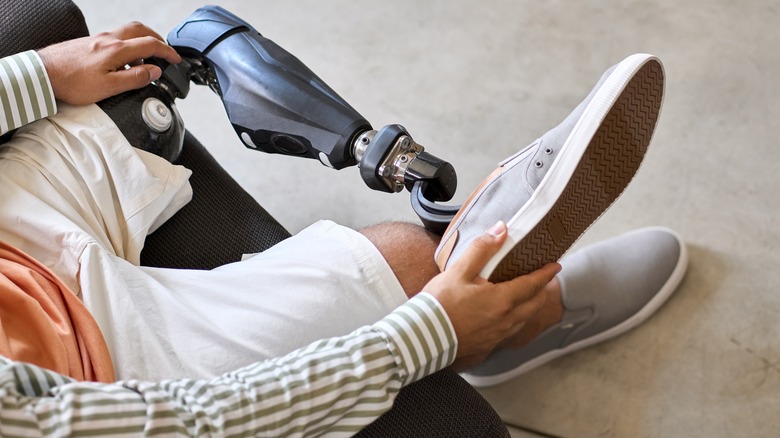What You Need To Know About Going Through TSA With A Metal Implant Or Prosthetic
Everybody — irrespective of their physical form — should have the right to travel. That includes people traveling with metal implants, medical devices, or prosthetics. Unfortunately, getting through airport security with an implant or prosthesis can be a little tricky. Medical devices and implants containing metal are known to set off scanners, while prosthetics require additional inspection. But don't fret: We'll share our best tips to avoid getting flagged by TSA if you use these medical aids.
Years ago, news stories depicted TSA agents as insensitive and invasive toward travelers with unique medical needs. In 2010, for instance, a flight attendant and breast cancer survivor claimed an officer forced her to show her prosthetic breast to be allowed through the security checkpoint. A few years later, in 2013, a Marine using leg prosthetics was humiliated after TSA made him remove his artificial limbs. Then, in 2016, a mother revealed to media outlets that her son, who requires a pacemaker, was kept in the security area for an hour and nearly barred from boarding his flight.
Thankfully, these stories aren't as common as they once were. Still, it's important to prepare before arriving at the airport. Learning your rights and screening options can help ensure your trip starts on the right track.
Metal implants can set off TSA scanners
Metal implants and devices can range from joint replacements to defibrillators and even screws in dental implants. However, the one thing they have in common is that they can set off body scanners and metal detectors — adding to our list of the oddest things you didn't know about TSA body scanners. With that said, having an internal medical device isn't a reason to be turned away by airport security personnel. According to the TSA, all you have to do is inform the checkpoint agent of your implant or device. There's no need to carry a special medical identification card or a letter from your doctor. You should also never be asked to expose the site of the implant or scar to prove it's really there.
If your airport offers advanced imaging technology machines, you may be able to pass through the scanner without any additional screening. In other instances, a pat-down of the implant area may be required. Note that some devices, such as pacemakers, shouldn't be exposed to metal detectors. If your airport only has walk-through metal detection machines, request a full pat down instead.
Expect additional screening when flying with prosthetics
Whether you choose to keep your prosthetics on your body or remove them while traveling, taking them with you is relatively straightforward. According to the TSA, prosthetic appliances are allowed in carry-on bags and checked luggage. If you prefer to wear your prosthesis, the agency notes on its website that you can do so. You can also opt to remove the piece and send it through the X-ray machine to simplify the screening process, though you should never be pressured into doing so.
When wearing a prosthetic appliance, getting through security can take a little longer than usual. TSA agents may examine your prosthesis with a metal detector wand and perform additional tests on the device for traces of explosives and other prohibited items. The Amputee Coalition also states that TSA officers may ask to see and touch your prosthesis, with the exception of breast prosthetics.
Though these procedures can be frustrating to deal with, complying with instructions will help you get through airport security faster. If you feel uncomfortable performing the screening in public, request a private one instead. And if you ever feel that an agent abused their power or harassed you due to your prosthetics, promptly file a complaint using TSA's online form.


